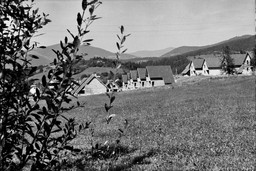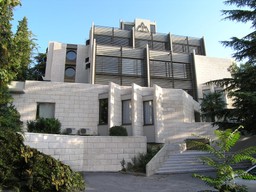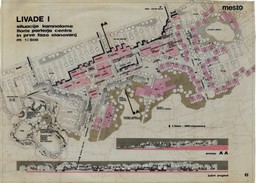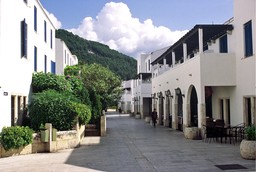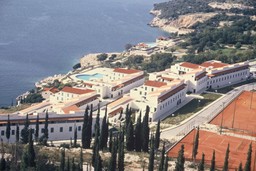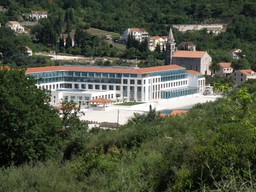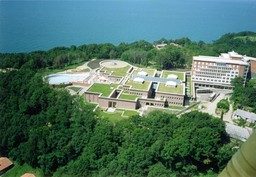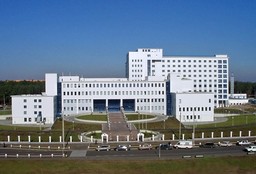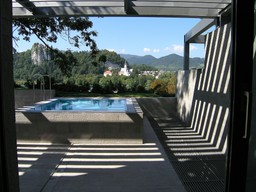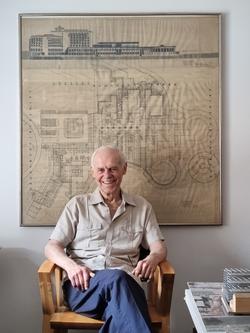
Janez Kobe in the LBA architectural office, Ljubljana, 2022; photo: Robert Potokar
Interview / Piranesi 46/47
Interview with Janez Kobe
Signature Design on a Grand Scale
by Robert Potokar
Janez Kobe, born in 1947, is a Slovenian architect who has worked in several countries, including Slovenia, Montenegro and Croatia, in the then common state of Yugoslavia, as well as in the former Soviet Union. He has won several architectural competitions, the most notable of which were those for the building of the Splošna plovba Piran in Portorož in 1974, and for the Slovenska Plaža in Budva in 1980. For the latter, he was awarded the Borba Federal Yugoslav Prize when it was completed in 1985. This was the highest architectural award in Yugoslavia at that time.
About his studies and competition prizes
Piranesi: You completed your studies at the Faculty of Architecture in Ljubljana. What was the topic of your graduation thesis, which you researched with Professor Ed Mihevc? I imagine there probably wasn’t much opportunity for consultation, because the professor was quite involved in the implementation phase of his projects at the time?
I was completing my studies in 1969 in Professor Mihevec’s studio, I had already passed all my exams, the only thing left was my graduation thesis which I wanted to accomplish as quickly as possible. The assignment was given to me by the Assistant Professor Brezar, namely a residential tower in Sečovlje. Mihevc extended it a little later to a whole settlement on the Sečovlje plot , which was to extend my graduation period at the faculty. Nevertheless, I finished my diploma quickly, and in 1970 I graduated as one of the first students of my generation.
Is there anything particularly memorable from your student years? Maybe an anecdote, a story about your professors and work methods? I know you socialised a lot with other students, and have kept in touch with some of them until today.
In Professor Mihevec’s studio we spent the days drawing, each of us on our own drawing board, and assistant tutors were present while the professor was busy in the drawing rooms, working seriously on the multitude of projects that were then underway all along the Slovenian coast. So Professor Mihevc would not come to our room at that time, at least not to me, but he did once, when I was not around, sharpen my pencil. We had another contact when, immediately after graduation, he greeted me on the stairs with “Mr Kobe, I was very pleased with your drawing”.
It was no better with Professor Ravnikar. While Mihevc himself gave lectures on his subject, Ravnikar did not give a single one, you could only see him on the steps of the school, and in his studio, of course.
Socialising was really an integral part of the study period. So a good part of my peers also became a regular part of our company at a later stage, with whom we would meet every day, every evening, go on trips, spend holidays on the seaside together, and later go skiing with our families, and every year for New Year’s to Dolenc at Stari vrh. It has remained like this until today, only we see each other less often and there are already fewer of us.
It was probably just after graduation, or even during your studies, when in 1971 you and co-authors Mirko Mrva and Borut Delak won a competition for a housing estate in Kotlje.
During our studies, we started to try our hand at competitions, and our first success was a buy-out prize for a hotel in Bohinj in 1969, and in 1971 a municipality in Carinthia launched a competition for a housing estate in Prevalje, on the site of a protected Alpine area at the foot of Uršlja gora. It was particularly encouraging because of the possibility of finding and designing quality regional architecture.
The result of the competition was that the project by Mirko Mrva was the basis for the layout of the approximately 200 individual and terraced houses that were envisaged, while the project I developed with my co-author Borut Delak was the basis for the architecture of all the implementation plans for the Alpine-style individual atrium and terraced houses of varying sizes.
Your biography notes that you received the Plečnik Award for Kotlje in 1978. Could you say something about that project?
The construction of Kotlje started in 1972 and lasted for quite a few years, and I have to say that we did not have much influence on the construction itself, except in the beginning, until we, together with the contractors and the investors, had mastered the basic postulates of the planned architecture. In the following years, the residents found their own way, and I had enough to do from 1974 with the competition and implementation of the Piran Splošna plovba in Portorož, and the first prize in the Yugoslav competition for the Livade residential complex in Izola in 1977 and the implementation immediately afterwards, and the Yugoslav competition for the Žusterna residential area near Koper – second prize. This was followed by a nomination for the Prešeren Award for the Splošna plovba in Portorož. It happened like this: a member of the jury called me on the phone and said that I was nominated for the award and that I should send the jury documentation and photos. I was unprepared and did not submit the material. A few days later, by way of consolation, I found out that we had been awarded the Plečnik Award for the Alpine village of Kotlje. All this happened in 1978.
The competition for the Piran Splošna plovba in Portorož, held in 1974, was something special. Can you tell us more about your winning solution? You were also nominated for the Prešeren Fund Award in 1978.
The competition sought to find the best solution for a large office building with garages, shelters, and machine rooms in an extremely sensitive location in a Portorose park with magnificent greenery, with four giant cedars in a classical formation under the museum villa, and a whole range of beautiful pine trees, cypresses and more. At the same time, the park is situated on a steep slope, which slopes down towards the sea and coastal road below the villa, while to the west the slope changes direction completely and faces the bus station. The design solution I saw was that the building is hidden and seemingly retreating behind all the trees and pines, the trees must not be cut down, so all the trees below have been incorporated into the terraces above the basement with the garages, they grow out of the newly created green terraces, the pool of greenery and trees complements and completes the new emerging image of the park.
This creates a composition of staircases on the sea and west sides, leading to the entrance reception floor with stone paving and green and planted terraces, with only the garage entrance open at road level by the entrance staircase and barely visible under the lush greenery.
